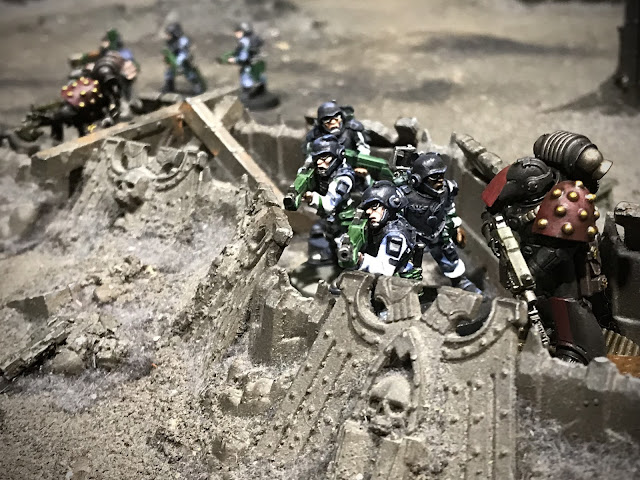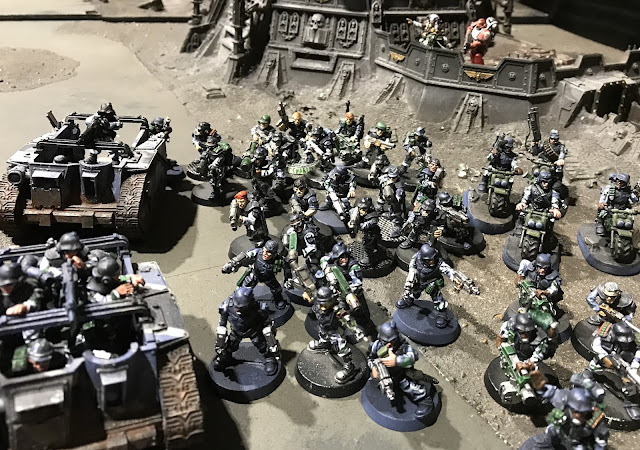Warzone Natakjuwa
Précis
[//Princip. belligerents={Orthodox alliance}//] +Charnel Guard/Death Eagles (II)/Eblan Regiments+]
[//Princip. belligerents={Partisan}//] +Wormwood Sons/Silver Stars/SaporanRegiments+]
A large-scale conflict in which the Partisans suffered a bloody but significant defeat, it was notable as a demonstration of the ability of a large number of rapidly-inducted Astartes to overcome the battle-hardened Partisan Companies.
It also highlighted the Partisans' utter system-level strategic superiority to Master Enoch and Stanizar Gorn, and led to the reforms that vastly improved the Pentarchy's macro-scale deployment during the conclusive Myrean League War.
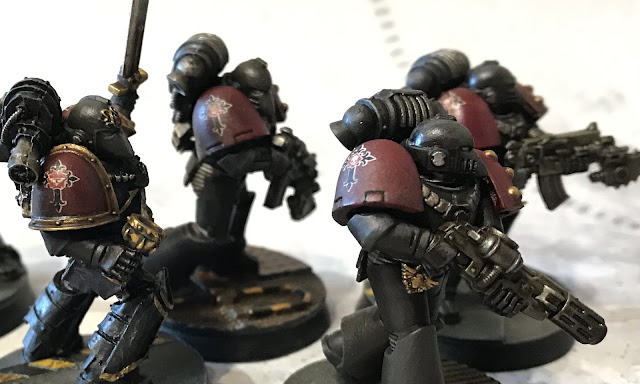 |
| [//Inductees forming the new 11th Company of the Charnel Guard are directed by a veteran Sergeant.+] [//josh_n/@disordered_retreat+] |
The Natakjuwa system held three Orthodox hiveworlds that had been heavily fortified – and harvested – by the Charnel Guard during the Sorrowful Years.
 |
| [//Namatkura, Natakjuwa System {tithegrade=} Decuma Extremis.+] |
While the populace of the Capital planet, Namatkura, didn't dare to openly rise up, an undercurrent of Partisan sympathy was clear. The system was thus deemed by Master Enoch to be an important anchorpoint of the spinwards regions, and he moved in person to shore up support, alongside an honour guard made up of two newly-inducted companies of Death Eagles II.
Aware of his actions thanks to the work of the Partisan-aligned Inquisitors operating alongside the Red Fish in the Delphurean League, Chapter Master Madu Iri-Abasza requested a force be deployed to the region. Partisan High Command complied, sending five companies of Silver Stars under Riverhead and – fatefully – diverting a Wormwood Sons' Extinction Force from Qorabbas to Natakjuwa.
***
Defeat in detail
Few Imperial campigns have ever operated on the colossal multi-sector scale of the War of the False Primarch. The vast majority restricted to particular regions, or occasionally entire planets. Even Crusades that target subsectors are, in practise, subdivided so that any one group of commanders is charged with relatively static, small-scale targets. Such was the nature of the Extinction Armada, for example – while nominally a single force under Master Enoch, in practise the Inquisitor was a figurehead, who had little direct influence over specific actions.
The reason for this is simple: the limits of the human mind in dealing with astronomical scale.
The most talented Imperial Commanders have been able, with the support of sufficiently well-equipped and supplied staff, to oversee a system-wide war. Beyond this scale, it becomes exponentially more difficult to account for the vagaries of supply, let alone to hold in one's mind the complexity of 'nodal warfare' across multiple planetary systems. Even the gods of war – the Astartes – are unable to properly account for every variable, and thus must delegate particular operations and specialisms to other groups and fields. In such a way, minor errors or oversights can quickly escalate and cause disaster.
This is seen by the High Lords as, on balance, a positive. It provides a hard ceiling of ambition for even the most talented strategic genius, causing rebellions to almost inevitably splinter, subdivide and becoming more likely to collapse under increasingly fractious or competitive drives amongst the leadership – even while smaller, more nimble taskforces of highly-professional Imperial Guard Regiments can be moved into position with simple orders to counter advances on a much smaller, planetary scale. In galactic warfare, protracted attack is infinitely more difficult than defence in detail.
That the Partisans had a seemingly uncanny ability to get their troops – and critically, their supplies – where they were needed, is undeniable. It's attested either directly, or by implication, in nearly all the remnant records. The reasons for this are deeply complex and contentious.
The single most heavily-redacted and scrubbed aspect of the war, only unreliable – and frequently contradictory – tertiary sources even hint at the nature of Volnoscere. Closer study of this figure is given elsewhere, but one of the more compelling arguments for him being something beyond the Astartes was the Partisans' greater success in prosecuting sector-wide warfare.
"Monstrance was aloft, and the battlefield paused. The great mace of the Last True Son swung down, and with it, came the death of nations. All across the region, thousands of warriors moved as one. I have never witnessed anything that moved me so much as being in the presence of a man that could move worlds with a gesture. Can such a being be truly called a man?"
That the 'Primarch' was seemingly rarely seen in-person is sometimes presented as evidence for his being an imposter. The opposing claim was frequently made that his taking the field a mere handful of times is the strongest evidence of all for the genuine nature of his claim.
The heroes of the Adeptus Astartes embody direct leadership. Captains and Chapter Masters are – by long custom – usually employed moderating strategy while present upon the battlefield. Here, their peculiar talents and abilities can be employed in the rapid adaptation perfectly suited to the Space Marines: that of applying overwhelming force to areas of the enemy. While the Masters of the Pentarchy like Gorn, Mor, Dwimmerlock and the like were taking the field against the Partisan Commanders like Solarion, Blégos or Kurst; Volnoscere seems to have prioritised command and control – which is likely where the mystique surrounding his Kapihe – or advisory circle – stems.
Such claims are fruitless without evidence, alas; and as the Edict of Obliteration left us with tattered fragments, they must remain inconclusive.
***
Countermeasures
"To admit defeat is to blaspheme against the Emperor."
The Pentarchy won a number of victories early in the war, but were thrown decisively onto the back foot by the Partisan counter-attack. By the mid war, the Partisans showed every sign of driving back the Pentarchy and demonstrating the strength of their cause.
This was unconscionable to the Pentarchy of Blood. Worse, the failure and following actions seemed to have driven their overall Commander, Jan Velghor of the Flesh Eaters, into depression, and eventually madness. The fate of Velghor finally made clear why Gorn of the Charnel Guard had been so closely shadowing his friend.
 |
| [//Stapan Stanizar Gorn, Master of the Charnel Guard+] [//matt_t/@spacedhulk+] |
As the first to hear of Velghor's fall, Gorn was well-placed to take over command without recourse to a time-consuming consultation with the newly-appointed Shadelord of the Carcharadons and the other Masters of the Pentarchy.
Ruthlessly, he moved to be invested by Enoch for 'pragmatic reasons' on Natakjuwa – arriving just after the Silver Stars and Wormwood Sons had been driven off. Enoch, seemingly impressed with the Charnel Guards' actions, agreed to invest the Angel with command of the Pentarchy.
From this point on, the Pentarchy of Blood was commanded with a greater allowance for his peers to make their own decisions, and also for considerably greater cooperation and collaboration. While the strategic changes following the succession were not always successful – Coldforge was to prove a bloody demonstration of the Red Talons' initial unwillingness to recognise Gorn's authority – by the time the Myrean League campaigns were enacted, the Pentarchy of Blood was operating with considerably more cohesion and success.
Where the Partisans had a greater command of grand strategy, the matchless numbers and directness of the Pentarchy were to prove increasingly successful in the key battlezones.
 |
| [//Silver Stars advance through the ruins of a Charnel Guard Abbey-barracks+] [//edward_r/@death_of_a_rubricist+] |
***
The Natakjuwa campaign
Directly prior to Gorn's investiture was the war on Namatkura and its sister planets in the Natakjuwa system.
Master Enoch's arrival on Namatkura was greeted dutifully rather than with rapture by the region's commanders. The symbol of the High Lords' authority was accompanied by two hundred Death Eagles (II), a Chapter that he clearly regarded as rather more reliable and measured – or to put it another way, controllable – than the wayward Red Talons, Carcharadons and others.
Indeed, were it not for the death of the Death Eagles' Chapter Master, Knyaz-Martial Broso, at the hands of the Partisans earlier in the war, it is likely that Enoch would have transferred command to his favoured servants once Velghor's fate became known. As it was, Gaius Gnaeus Titanus, Broso's successor, was far too inexperienced to justifiably advance. The politics made Gorn a preferable and reliable option – and as his level-headed command was to prove – a wise one.
Enoch was ferried to more than a dozen Charnel Guard Abbey-barracks across the system in the weeks preceding the Silver Stars' and Wormwood Sons' attack. Each barracks was the site of a rapid-induction and implantation campaign ordered by Gorn before he had moved to shadow Velghor in Qorbarras.
Each of the Pentarchy Chapters had approached the super-recruitment in a different manner, as best suited their peculiar circumstances and Chapter culture. Where the Death Eagles (II) had opted for simply increasing their existing recruitment methords – throttling their raw numbers but keeping the quality as high as they demanded – the Charnel Guard had managed to streamline and accelerate recruitment.
***
Fresh blood for the High Lords
It was reported to Enoch – with apparent regret – that the Charnel Guard had suffered a great number of failures in implantation, though these were broadly in line with predictions and calculations. Nevertheless, the Charnel Guard's Apothecarion guardedly reported that they had met with success in expanding the Chapter:
'[...]production of more than two thousand Novitiates in ten years, from a pool of four hundred thousand prospects. Another million of the region's youth have volunteered for service with the Chapter's Postulants [the Veterans training the new Marines]. Alongside similar Abbey-barracks across Sector Heliopolis, we expect refinements to the process will see a ceiling of seven thousand Charnel Guard able to be deployed by the decade's close.'
While the estimated numbers were broadly accurate at the time, what remained seemingly undisclosed was the number of retained failures – the infamous sclav-mort of the later war. Secondly, the Natajuwa War was to prove costly, as the Partisan attack seriously disrupted recruitment and training here.
This information is also considerably at odds with the Partisan Inquisitor Eos Margyll's testimony of The Bloody Yield, which suggested that the Charnel Guard had operated a considerably less orderly induction process than was presented here. If his account is to be believed, the Scouts and Astartes present on Namatkura were the stolen and weaponised children of Morqub.
[//Master Enoch pictured alongside fresh Charnel Guard recruits and Veterans from the Death Eagles (II)+]
[//josh_n/@disordered_retreat et edward_r/@death_of_a_rubricist+]
***
Human and post-human
Enoch was invited by the planet's Imperial Commander, Jenet Sawako, to inspect the Imperial Guard forces and Planetary Defence Forces stationed on the planet. As befitted a civilised Hiveworld, the planet had a colossal army, made up of many millions. This had been swollen by a number of Orthodox Imperial Guard Regiments, both intact and those amalgamated following the Delphurnean League War.
While it was unsuitable for extensive fleet anchorage owing to the high volume of intra-system merchant traffic, Natakjuwa was a convenient staging post for barracking Army forces. Distant enough from Morqub to allow for easy defence, it was sufficiently close to act as a post for cycling war-weary troops out of the ongoing Delphurnean League war. The principal planets of the system were thus very familiar with the cost of the ongoing war, which was now stretching into being many decades old.
The regiments of the planet were to have their first taste of invasion at the hands of the Wormwood Sons and Silver Stars.
| ||
Despite the presence of the Astartes on both sides during the Natakjuwa War, the vast majority of the action was undertaken by the Imperial Guard, Orthodox and Partisan alike. More than ten million soldiers were involved in the two years of the war, with both sides able to direct and command the troops effectively.
The immediate prelude to the War was marked, to the Imperial Commanders' shame and embarrassment, with a substantial uptick in the number of riots and uprisings amongst the populace. These were almost certainly stoked by Partisan agents operating throughout the three worlds, but the scale and readiness of the populations to rebel was marked – perhaps reflecting the war-weariness and drawing on morale caused by being effectively under occupation for more than most of the populace's lifeime.
 |
| [//Riverhead of the Silver Stars+] [//edward_r/@death_of_a_rubricist+] |
Able to land virtually uncontested thanks to the uprisings, and to naval superiority, Riverhead of the Silver Stars personally spearheaded the attack on Natakjuwa, presumably delegating the assault on the other planets in the system to now-lost underlings or allies.
Given the high radiation levels still prevalent across Natakjuwa, it is likely the Wormwood Sons were involved in the initial assault; and it is a fair assumption that the Charnel Guard abbey-barracks were the principal targets.
The war for Natakjuwa was to last for three years in total, though the bulk of the fighting was over in six months. It saw the frst campaign of many of the newly-inducted Charnel Guard when it became apparent that the Imperial Guard were not sufficient to drive off the concerted attack.
In fact, the principle weakness of the Orthdoxy was unavoidable – with the Partisans having established orbital dominance, they were able to target the large and unwieldy Orthodox Imperial Guard formations almost at ease. Coupled with this was their greater ability to direct their own Imperial Guard forces, leading to a level of success that was perhaps flattering the ability of the men and women of the Partisan regiments.
Within four weeks of the invasion, the Charnel Guard had managed to reorganised and distributed the new arms and armour that Enoch had brought with him, and nearly one thousand new Charnel Guard warriors stood ready to fight. However, they were largely raw and untested. Fewer than one complete Company of veteran Charnel Guard were stationed on the planet, and their Captain – a notably level-headed individual named Grauens – seemed unwilling to commit either his own men, or the the fresh troops under his aegis, to the meatgrinder.
For an additional three weeks, he resisted calls of regional Imperial Command to deploy his forces, instead opting to hoard and protect his master's investment.
 |
| [//Captain Grauens, formerly of the Third Battle Ostire+] [//dave_b/@heretic_dave+] |
The Charnel Guard, however, were far from idle. Grauen tasked his veterans with bringing the neophytes into order, putting them through accelerated training, gruelling even for the Astartes. In this way, Grauens hoped to have a fresh force ready to combine with Gorn's returning army – for word had travelled swiftly to the Charnel Guard that Velghor had fallen, and that Gorn was en route.
 |
| [//Veteran Charnel Guard; assault squad+] [//dave_b/@heretic_dave+] |
***
Horrors of war
Unlike the campaigns in Morqub, where Partisan invaders had been keen to minimise collateral damage, it appeared that Riverhead and the Wormwood Sons were determined to salt the earth for their enemies wherever possible.
Given that fewer than one hundred Wormwood Sons are believed to have been deployed to the region, the impact they had on the war was vastly out of proportion. While no records of orders have ever been recovered, given Riverhead's known bellicose and stubborn nature, it seems likely that he either directly requested the Wormwood Sons' culture-eradicating specialities, or at the very least refused to restrict them.
More than four thousand high-yield nulltomic warheads are recorded as having been used in the conflict, which – given its relative brevity – was vastly out of kilter with any idea of subsequently occupying the region. The war for Natakjuwa was not one of territory, but de facto of survival.
The Silver Stars and Wormwood Sons were determined to strangle this particular snake before it could grow.
***
Besides the obvious destruction of more than a dozen hives, null-point fallout made the conflict hellish for the soldiers called to claim territory. Long supply lines were necessary to bring untainted food and water anywhere near the front, and the Natajuwan and allied local forces undoubtedly suffered huge privations as they were needled and engaged by roving Silver Stars and Wormwood Sons warbands, small groups of Astartes warriors leading scratch companies or even entire regiments. |
| [//Eblan Stormtroopers stage a successful raid on a Partisan landing field; one of the numerous small victories in this see-sawing conflict.+] [//nick_c+] |
***
Embattled
Natakmura was always a harsh world, close to the system's star. This made it uncomfortably (but not usually dangerously) hot. While the worst of the solar radiation was mitigated in the primary continent by the timing of the strike – during the region's winter – the harsh lighting was a continuous problem for all forces.
The Wormwood Sons' actions had made entire regions no-go to unenhanced humans, further channelling advances into particular valleys and defensive bluffs, where Partisan naval forces could bombard them. The Orthodoxy's counter to this was to make broad use of the hiveworld's manufacturing capability, churning out thousands of cheap-and-cheerful transports. By the end of the war, more than forty per cent of the defenders were armoured or mobile infantry.
As the Partisans dig in and made static defences – guided by the reliable (and thus predictable) Silver Stars' modus operandi, the Death Eagles (II) came into their own. Few in number, they demonstrated a fantastic ability to improvise and work alongside the Orthodox Imperial Guard in inventive ways.
 |
| [//Death Eagles spearhead an outflanking force on Partisan trenchlines. Note the presence of embedded Silver Stars.+] [//nick_c et edward_r/@death_of_a_rubricist+] |
That the Death Eagles' command helped spare unnecessary death is clear; and their tactics were also extremely successful. Blitzkrieg, refused deployment and false flag operations made their small numbers count double, and the Silver Stars and their allies were increasingly brought to a standstill.
The war thus settled into an uneasy stagnation, with both sides making limited advances. Only the Wormwood Sons were marked out as exceptional here, as they managed to infiltrate and detonate n-bombs on repeated occasions – and the loss of the entire 26th Company of the Charnel Guard before they even deployed can likely be attributed to their sabotage actions during this period.
It is likely that the forces of Forgeworld Kadath were in action alongside the Wormwood Sons in these attempts – though given the planet's studied stance of neutrality, it is possible that this was fictionalised later, in order to justify the assault on the Forgeworld in the late war.
 |
| [//Unsubstantiated rumours suggest that Kadathi Skitarii were present on Natakjuwa, fighting for the Partisans in support of the Wormwood Sons.+] [//nick_t/@k0rdhal+] |
***
Unleashed
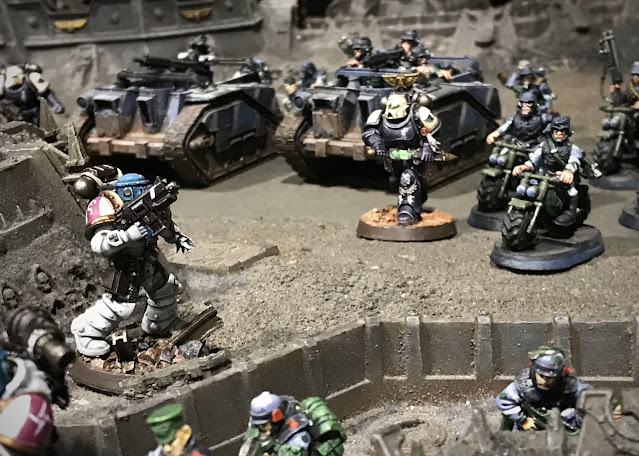 |
| [//A Death Eagle confronts the Star, each backed by brave Imperial Guards-men and -women.+] [//nick_c et edward_r/@death_of_a_rubricist+] |
Records beyond this point are few, suggesting that the war lasted only a short time after Gorn returned. His opinion on Captain Grauen's decisions are unclear, but whether he praised or cursed the Captain, from this stage on, the Charnel Guard were loosed.
Led by experienced veterans tasked with preserving the investment wherever possible, the Charnel Guard conducted a notably cautious and cool-headed campaign. This may, in part, be attributed to the lack of armour and support that the newly-inducted brethren enjoyed. Most of the Charnel Guard's armoury had been whittled away during the earlier war, and while Enoch had borne armour and boltguns aplenty, there was little specialist weaponry or vehicles to help.
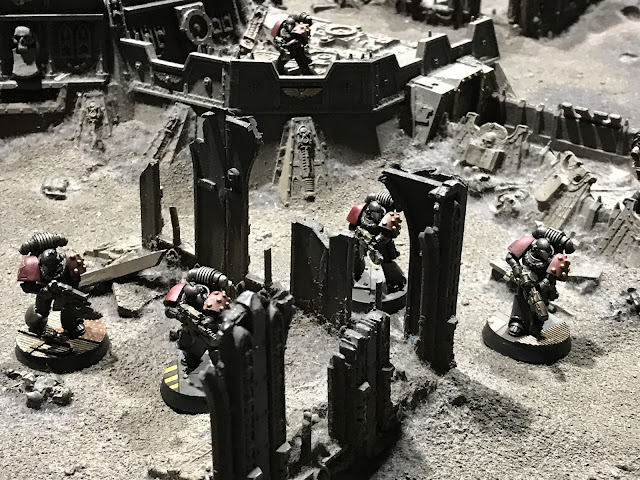 |
| [//11th Company Charnel Guard advance through another ruined hive-district+] [//josh_n/@disordered_retreat+] |
The bulk of the fighting was still being carried out by Guardsmen on both sides in a gruelling war of attrition. The Charnel Guard adopted a strategy of rapid deployment to shore up human-on-human engagement, ensuring that the battle was turned in the Orthodoxy's favour without having to commit to counter-Astartes action.
This was taken as a tacit admission of weakness on the part of the Partisan forces; and Riverhead furiously insulted and belittled the 'cowardly' behaviour of his counterpart. The Wormwood Sons' opinion was dismissive – and this was a likely factor in the eventual overextension of the Silver Stars in trying to bring the Charnel Guard to battle. Had the Wormwood Sons offered some caution, perhaps Riverhead's stubbornness might have been ameliorated, saving thousands from an unnecessary death.
 |
| + Eblan rapid-response forces follow up Charnel Guard advances to prevent re-occupation by retreating Partisan troops + [//nick_c+] |
As it was, the war dragged on for a few more weeks, where it might instead have been possible for a successful retreat. From this point onwards, the Partisans would achieve little more – and indeed, needed to achieve little more.
It seems unlikely that Volnoscere intended Riverhead to bring the Charnel Guard to battle – and since the Silver Stars had already critically disrupted the recruitment process, it is likely that all of the goals of the war had long since been achieved. The Silver Stars were thus merely bluntly and unnecessarily extending a war that neither wanted to fight in this place.
 |
| [//Partisan Guard (bottom of pict-capture) attempt to fend off advancing Eblan elites. Thousands of mortal soldiers would perish in the closing days. +] [//nick_c+] |
As morale plummeted amongst the armies of both sides, elements of the Charnel Guard were at last encouraged to take more of an active role, and this final change in strategy saw hundreds of relatively fresh Space Marines pumped into the conflict zone.
***
Post-campaign propaganda made little of the Natakjuwan war – for the region had undoubtedly suffered badly. It was no great victory in which either side could take pride, and Gorn was more interested in keeping what little secret he could of his recruitment grounds.
Nevertheless, it appears that he personally authorised the use of footage and information from the war to be distributed – with a number of critical details changed. An example is below, taken from a broadsheet news-pamphlet distributed across Heliopolis.
'The warriors of the 11th company were newly inducted when the Partisan assault on Abraxas hit. As the tides of battle washed across the sub sector, they rapidly grew to become an effective and feared close assault formation, cutting down mortals and Astartes alike with (mostly) controlled savagery.'
Note the deliberate conflation of the Abraxas system battle with this war. While the 11th did take part in both, it is notable that no rolls of honour exist for Natakjuwa.
***
Retreat of the Stars
 |
| [//Charnel Guard find the Wormwood Sons tough enemies to face... but numbers inevitably tell.+] [//nick_t/@k0rdhal et josh_n/@disordered_retreat+] |
The Partisan commander thus reluctantly signalled the order to retreat when reports of blockade-running Orthodox craft began to filter in. Riverhead was not troubled by sentimentality, but equally refused to abandon his mortal allies – whether through a sense of duty, honour,or sheer bull-headedness is unclear.
 |
| [//Riverhead urges on his troops+] [//edward_r/@death_of_a_rubricist+] |
Thus was fought the largest of the few Astartes-on-Astartes conflict of the war, with the Silver Stars advancing en masse against one of the surviving Abbey-barracks of the Charnel Guard. This strike was likely intended to draw in Gorn himself, Riverhead perhaps hoping to engage his enemy in single combat, but such was not to be.
Gorn was, by this point, applying himself to the broader strategies of large-scale warfare, and attempting to apply long-forgotten Legion-scale organisation to his swelling armies. He had – correctly – delegated the defence to his trusted Captains, old and new, and as a result, the three-hundred or so Silver Stars were met by a ragged coalition of roughly five hundred Charnel Guard.
The Silver Stars tactics were perhaps inflexible – seemingly modelled as they were on ideas outmoded even by the close of the Great Crusade – but remained effective. For all their antique strategies and equipment, the strange pseudolegion proved deadly in the ruins; their experience and familiarity with one another far outweighing any advantage granted the newly-inducted Charnel Guard by their modern plate.
Both forces suffered heavy, though not deadly losses, and the Silver Stars were forced to withdraw before they could destroy the Abbey. Proportionally, each Silver Star downed managed to bring down three to four of the new-breed Charnel Guard – and this is particularly notable owing to the Silver Stars' poor showing earlier in the war. Either the pseudolegion was adapting, or these were particularly Veteran warriors accompanying Riverhead.
Perhaps Riverhead considered honour satisfied – and the attack had drawn in the Charnel Guard from regions nearby, allowing mortal forces to fall back and begin the evacuation.
While the battle for Abbey-barracks Enton was the only large-scale Astartes conflict, it was not the only time the Astartes clashed. The hurriedly-formed 11th company of the Charnel Guard was made up of the oldest of the Chapter's inductees, and had benefitted from crucial months more training and experience.
Their Captain, Canemir, was a decorated veteran, and he was determined to properly blood his troops against a worthy foe. It was the Wormwood Sons, who had so grievously wounded the world under their charge, that would suffer at his hands.
As the Silver Stars ordered the retreat, the Wormwood Sons were still on extended kill-team operations. Most were now faced with the challenge of exfiltration from their positions deep within Orthodox lines.
The retreat was piecemeal and mostly succesful, but more than two dozen Wormwood Sons would be hunted down by the vengeful and eager Charnel Guard of 11th Company.
 |
| [//nick_t/@k0rdhal et josh_n/@disordered_retreat+] |
***
Mournful victory
 |
| [//nick_c+] |
Inevitably, as the Partisans fell back, the Orthodox forces moved forward. Their nature as armoured infantry meant they could advance with surprising speed, and the retreat was marked by a number of conflicts and outflanking manoeuvres that saw numerous Partisan forces isolated and destroyed.
 |
| [//Eblan Regiments liaise with their outriders, and prepare to move on quickly+] [//nick_c+] |
 |
| [//Isolated Silver Stars prepare to sell their lives dearly+] [//edward_r/@death_of_a_rubricist et nick_c+] |
Both sides claimed Natakjuwa as a victory. The Partisans had successfully disrupted the Charnel Guard's recruitment here, but had turned a successful first strike into a cloying and unnecessarily bloody war from which they had been forced to retreat.
Enoch was impressed with the Charnel Guards' actions, praising both them and the Death Eagles that had 'fought the horrors with dignity and strength'.
Privately, however, Enoch and Gorn were quietly horrified by the casualty ratios exhibited between the forces, and in concert, they began to discuss the Orthodoxy's next steps in countering the Partisans. No quarter could be given.
[+//identspoolunrequited+]
Privately, however, Enoch and Gorn were quietly horrified by the casualty ratios exhibited between the forces, and in concert, they began to discuss the Orthodoxy's next steps in countering the Partisans. No quarter could be given.
[+//identspoolunrequited+]
[+bracketspool unhinged+]
[+recalib+]
[{ERRORSHuNTABORT}]+]
[{ERRORSHuNTABORT}]+][{ERRORSHuNTABORT}]+][{ERRORSHuNTABORT}]+]
 |
| [//josh_n/@disordered_retreat+] |
[{ERRORSHuNTABORT}]+][{ERRORSHuNTABORT}]+][{ERRORSHuNTABORT}]+][{ERRORSHuNTABORT}]+][{ERRORSHuNTABORT}]+][{ERRORSHuNTABORT}]+][{ERRORSHuNTABORT}]+][{ERRORSHuNTABORT}]+][{ERRORSHuNTABORT}]+]
 |
| [//Victory! Eblans parade through deserted streets – the underlying discontent of the populace reinforced by the brutal pressure of the short war.+} [//nick_c+] |
